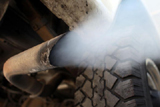Medical research
Collective bio-energetic detoxification
Abstract
This exploratory study of air-pollution focused on petroleum and auto gasoline exhaust. After exposing a water-filled jar to open air for two days, both chemicals were detected, using muscle-testing of the jar together with two electronically sensitized vials. Both chemicals were next induced into a nearby centre for which an Integral Bio-Energetic Field had earlier been created. Then, a second water-filled jar was exposed to open air for two days. Subsequently, both chemicals could no longer be detected.
Introduction
A series of three articles titled ‘Creating a Healing Atmosphere’, in NAMAH (from April 2015) described the development, generation and benefits of a healing atmosphere, known as IBEF, Integral Bio-Energetic Field. IBEF, created last year at several local centres, was accomplished with divine guidance and the application of a complex bio-energetic vial (1). The present article examines IBEF dynamics on a collective level, focusing on two components of air-pollution, as measured by the techniques of muscle testing, known as ‘Question Response Testing’ (QRT) and ‘Predetermined Muscle Testing’ (PDM). Both techniques — derived from the discipline of Applied Kinesiology — have been used extensively by alternative medical practitioners.
Evaluation approach
As an exploratory study from a bio-energetic perspective, its basic methodology follows four sequential stages. First, baseline measures (using muscle testing) are obtained concerning the issue (air-pollution); second, the core component (above two chemicals) is identified and induced into an IBEF centre; third, IBEF energy is directed toward the component; and fourth, follow-up measures are obtained as to IBEF impact upon the issue component.
A brief explanation of muscle testing and the two techniques used, QRT and PDM, is pertinent.
The body’s electrical energy reveals much about our state of health and well-being. The energy flows through our nervous system, which also controls the muscles. When there is a blockage of electrical energy, it manifests as a weakening of the muscle, such as the finger joints, or the skeletal muscle of the extended arm.
As mentioned, two forms of muscle-testing were applied: QRT and PDM. For QRT, a question is stated, followed by muscle testing. A frequently used method is to gently press the tip of the middle finger upon the upper first joint of the index finger. A relatively ‘strong’ muscle means ‘Yes’, a ‘weak’ muscle ‘No’.
For PDM testing, a recipient’s arm is extended, held firm, and the wrist muscle pressed downward by the practitioner — while the recipient is holding a substance or the vial energised for a given substance. A normally strong muscle indicates ‘no reactivity’; a relatively weak muscle shows there was ‘reactivity’, i.e., in effect, a blockage of electrical energy.
Air pollution
Various chemical substances — stemming from modern technology, transportation vehicles, and industrial waste emission — contribute to atmospheric pollution. The present study focuses on two pollutants: petroleum emission and its related component, automobile gasoline exhaust.
Baseline data
To assess the two components of air-pollution, the investigator employed two steps. First, he PDM-tested a glass jar filled with fresh water, together with a bio-energetic vial for petroleum — there was no reactivity (‘strong’ muscle). He repeated the procedure, but using a vial for gasoline exhaust – again, there was no reactivity.
Next, the investigator placed the water-filled glass jar outside in the open air. After two days, he repeated the above PDM tests. For both tests there was reactivity. Evidently, open air exposure for two days had resulted in the water becoming polluted with trace amounts of the two chemicals.
For additional supporting evidence, the investigator placed a water-filled glass jar inside his house for two days. PDM-testing after the two-day period showed no reactivity, i.e. the water had not become polluted.
Induction
For the next stage, the investigator aimed to induce the two vial chemicals — petroleum and automobile gasoline exhaust — into an IBEF centre’s energy field. For the induction, he obtained the help of an assistant, Allison, a staff member at the centre. Her initial PDM-testing for each of the two vials showed a ‘weak’ response. This indicated that the two vial chemicals had not been induced, were not present in the centre’s energy field.
Thereafter, the investigator infused each of the two vial chemicals into the centre by applying the IBEF induction technique (2). He then repeated Allison’s PDM testing and this time found a ‘strong’ response for both vials, meaning that the two vial chemicals had been induced into the IBEF energy field.
IBEF Extend Mode
QRT testing by the investigator showed that the Extend Mode was active — IBEF energy is being extended beyond the centre, covering a 5-mile radius. The QRT result was confirmed by the separate testing of the investigator’s assistant, Jasmin.
Induction result
Shortly after the induction stage, the investigator again placed a water-filled jar on the outside balcony for two days. Thereafter, upon repeating the PDM-testing he found no reactivity for the water in conjunction with each of the two vials. This result was confirmed by the separate testing applied by the assistant, Jasmin.
From a standpoint of scientific methodology, the above tests of the water-filled jars by the investigator were not ‘double-blind’ but ‘open’, i.e., the investigator knew which jar was baseline and which one had been IBEF induced. His assistant, Jasmin, however, was not informed as to which jar was induced during her testing. Thus, the exploratory study was conducted partially on a scientific level.
Conclusion
The findings suggest that air pollution involving petroleum and auto gasoline exhaust is reduced by applying the IBEF energy field which had been infused with the two types of chemicals. The anti-pollution effect, however, may be limited to within a 5-mile radius of the IBEF centre.
Several aspects of the study may be further explored. Additional questions might be:
• For how long would the anti-pollution effect be sustained?
• Can it be extended beyond a 5-mile radius?
• Would the induction need to be reset after certain time intervals?
From the perspective of the Integral Yoga, the study results indicate that the divine Grace and guidance were present at the IBEF centre.
References
1. Seckel JP. Creating a healing atmosphere within centres and for a spiritual community: an investigative study NAMAH April 2015; 23(1): 20-30.
2. Seckel JP.Creating a healing atmosphere within centres and for a spiritual community: an investigative study – II NAMAH July 2015; 23(2): 27-30.
Joachim P. Seckel, M.A., Acupr., NAET is a researcher based in Albany, California.
Share with us (Comments,contributions,opinions)
When reproducing this feature, please credit NAMAH,and give the byline. Please send us cuttings.




